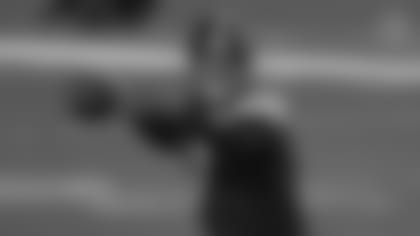Q. The Sammie Coates situation in the game against the Jets: If there was going to be a decision made to sit him because of dropped passes, is that your call?
A. Yes.
**
Q. In your mind, what was it about that situation that lent itself to sticking with the player?**
A. He was making more plays than he wasn't. His attitude was a good one. He still appeared to be very much into the game from a mental standpoint, and we recognize where he is from a growth and development standpoint. It was a great opportunity for us to show the resolve we want him to show, and to support him in that way. It was an easy decision.
Q. When a guy is going through something like that, is there a conversation with him – either a pat on the back or a kick in the butt – or are dropped balls just a part of the game?
A. I had several conversations with him during the course of the game. I played the position, so I know a wideout is going to drop a ball now and then. It's not alarming or concerning to me until I think it may affect their ability to make the next play. So I communicated with him at several points during the game, and I never sensed that the drop or the drops would prevent him from making the next play, and so I supported him.
Q. Every Friday I believe it is, the defensive backs get together after everyone else is gone. I've seen them in the Bill Nunn Draft Room. What's happening in there at that time?
A. It's called the Winning Edge meeting, and that's essentially what they're doing. They're searching for the winning edge, some nugget, some 11th hour nugget that might be the difference in performance, that might give them a leg up in terms of the opponent. Sometimes it's information, sometimes it's a technique, sometimes it's coordinating communication in greater detail between two or more men. It could be a variety of things, but more than anything it's a commitment that the group has made to put in collective additional time to increase our chances of winning.
Q. Are you in the room with them?
A. I am. I generally run it, but again, it's requested by them for them.
Q. Because the defensive backs were your unit as a young coach, do you have a special interest in them?
A. I have a soft spot for any unit in need. In my present position, I'm the head coach and that's what I look for. I look for groups or units in need and work to provide them with what it is I think they need. I can't slide to an area of my comfort. I have to keep an eye on all 53 and provide them with what it is they need. So in general, I'll gravitate to the group I think is one that's in need. I used to have similar meetings with the offensive line several years ago. That comes with the job.
**
Q. Because of the way the NFL game is played now, is the defensive backfield a more important unit than it was 20-30 years ago?**
A. I think it is because of the depth that's required. The amount of sub-package football in today's NFL puts a premium on that unit, and not only the guys you anticipate playing but also the natural attrition that's a part of the game. Whether you lose somebody to injury or otherwise, now you're dipping in – for sub-package and dime-package, for example – to a practice squad-like cornerback as opposed to an active squad-like cornerback. The depth of that group gets tested in ways that the depth of other groups don't get tested in today's NFL.
Q. Generally speaking on defense, who and/or what determines whether a cornerback lines up tight on a receiver at the line of scrimmage, or off a receiver at the line of scrimmage?
A. There are a lot of variables. It could be down-and-distance. It could be personnel, as in who that receiver is. It could be schematic, in terms of what our calls are and where his potential help is. It's a myriad of things, and that element of the plan is hardened up over the course of the week. Usually that picture doesn't become clear until a day like Friday.
Q. You mentioned two things there. Scheme, and the ability of the receiver. Is how the cornerback lines up determined more by one of those things than the other?
A. It really depends on the scheme, and I'm really not dodging your question. But in some defenses or calls or structures, the help is more imminent than in others, and so it depends on how much direct help you have.
Q. Is it ever OK for a cornerback to be lined up behind the first-down marker on a possession play?
A. Yes.
Q. Because of the scheme?
A. Yes.
**
Q. Then what would be a part of that scheme then that would prevent a simple pitch-and-catch to get the first down?**
A. It maybe somebody, by scheme, who is designed to show up underneath that receiver. That's an element. We have guys at the end of the line of scrimmage for us who stand up as outside linebackers. Sometimes they come, sometimes they drop. Sometimes in the midst of dropping, they buzz out underneath. So we could seemingly look like we're providing a pitch-and-catch but actually we're not. Stephon Tuitt almost had an interception in Washington because we provided that look – he showed off-coverage, it was a possession down, Arthur Moats was standing at the end of the line. The ball was snapped, Arthur Moats buzzes out underneath the receiver, they threw the ball to the inside, and really Ross had the best chance of making the play. I know I don't always answer your question directly, but it's not just about the wideout, it's not just about the corner, it's not just about the call. Sometimes it's about the other people and where his imminent help is or is not.
Q. The team signed Karlos Williams to the practice squad. He is Vince's brother. Any hesitancy there having family members on the same roster?
A. No, none at all.
Q. Is it as an advantage to have family members on the same team?
A. We really didn't look at it in that way. We acknowledged that Karlos is Vince's brother, but it really had no bearing on our interest or level of interest. It wasn't like Karlos was an unknown commodity. He's a running back from Florida State who scored nine touchdowns in Buffalo last year as a rookie. So when you start talking about those credentials and an available practice squad spot, really it's kind of an easy discussion.
Q. Since Vince was here first, and is older, is he responsible for Karlos? Is Vince his brother's keeper, show him around, teach him how the Steelers do business?
A. Not at all. Not anymore than he would do that for anybody else.
Q. Who is Miami's key guy on defense?
A. I'd say Cameron Wake. He's the guy who has a distinguishing characteristic that's capable of changing the game in an instant. His quickness and burst are unique, they're still unique as he pushes into his mid-30s. He's the guy who could change the game if you're somewhat one-dimensional due to game circumstances or you're behind the chains. That makes him extremely significant.
Q. Besides Ryan Tannehill, who would the key guy be on offense?
A. Jarvis Landry, their talented receiver out of LSU. His targets probably outnumber the next available guy by 3:1, but aside from that he's got a well-rounded game. He's physical in the run game, and that puts him at the point of attack. He is their gadget guy. They throw him the wide receiver screens. He's the third-down leading target. You name a situation, and he's front-and-center in terms of what it is they do. He's as critical to their performance as anybody we have played, and that includes Brandon Marshall's contributions in New York or A.J. Green's contributions in Cincinnati, to name a few.
Q. Which stat, other than the final score and turnover ratio, do you think will be the one to reflect the outcome of the game? Last week, you said third-down conversions. It was 50 percent for the Steelers, and 18 percent for the Jets.
A. It's a combination stat, and you might not like it. It's the hidden special teams yards, and how you define it is the net punting and the drive start locations in the kickoff game. Our punt team has to do a great job of covering, because they ran a punt back last week. Our kickoff team has to do a great job of covering if they choose to attack us. We're going to have some opportunities there. Their punter is averaging 48 yards a punt. When I see that, that means opportunity to us. That means No. 84 may have the ball in his hands plus the opportunity to make some moves before he addresses the coverage unit. So I think those hidden yards in the kicking game – drive start for kickoff and kickoff return, and net punting are going to be very significant.














